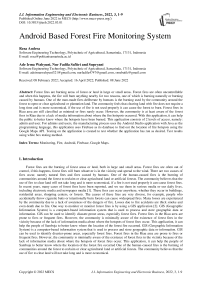Android Based Forest Fire Monitoring System
Автор: Reza Andrea, Ade Irma Wahyuni, Nur Fadila Safitri, Supryani
Журнал: International Journal of Information Engineering and Electronic Business @ijieeb
Статья в выпуске: 3 vol.14, 2022 года.
Бесплатный доступ
Forest fires are burning areas of forest or land in large or small areas. Forest fires are often uncontrollable and when this happens, the fire will burn anything nearby for two reasons, one of which is burning naturally or burning caused by humans. One of the man-made fires deliberate by humans is the burning used by the community around the forest to open or clear agricultural or plantation land. The community feels that clearing land with fire does not require a long time and is more economical, if the use of fire is not used properly it can cause the forest to burn. Forest fires in Riau area are still classified as minimal or fires rarely occur. However, the community is at least aware of the forest fires in Riau due to a lack of media information about where the fire hotspots occurred. With this application, it can help the public to better know where the hotspots have been burned. This application consists of 2 levels of access, namely: admin and user. For admins and users, the manufacturing process uses the Android Studio application with Java as the programming language, this application uses Firebase as its database to find out the location of fire hotspots using the Google Maps API. Testing on the application is created to test whether the application has run as desired. Test results using white box testing method.
Monitoring, Fire, Android, Firebase, Google Maps
Короткий адрес: https://sciup.org/15018429
IDR: 15018429 | DOI: 10.5815/ijieeb.2022.03.01
Список литературы Android Based Forest Fire Monitoring System
- P. Proctor, P. C. Van Deusen, L. S. Heath, and J. H. Gove, “The Open-Source Movement : An Introduction for Forestry Professionals,” pp. 203–208, 2003.
- P. Wikström et al., “The heureka forestry decision support system: An overview,” Math. Comput. For. Nat. Sci., vol. 3, no. 2, pp. 87–95, 2011.
- I. Zamula, M. Tanasiieva, V. Travin, V. Nitsenko, T. Balezentis, and D. Streimikiene, “Assessment of the profitability of environmental activities in forestry,” Sustain., vol. 12, no. 7, pp. 1–15, 2020, doi: 10.3390/su12072998.
- B. Felbermeier, A. Hahn, and T. Schneider, “Study on User Requirements for Remote Sensing Applications in Forestry,” ISPRS TC VII Symp. – 100 Years ISPRS, vol. 38, p. 7B, 2010, [Online]. Available: http://www.isprs.org/proceedings/XXXVIII/part7/b/pdf/210_XXXVIII-part7B.pdf.
- A. Jaafari, J. Rezaeian, and M. S. Omrani, “Spatial prediction of slope failures in support of forestry operations safety,” Croat. J. For. Eng., vol. 38, no. 1, pp. 107–118, 2017.
- G. Schüler, “Identification of flood-generating forest areas and forestry measures for water retention,” For. Snow Landsc. Res., vol. 80, no. 1, pp. 99–114, 2006.
- T. Zhang and Z. Tao, “The channels and demands analysis for Chinese farmers’ agricultural information acquisition,” International Journal of Wireless and Microwave Technologies, vol. 2, no. 3, pp. 56–61, 2012.
- K. Hamzah, “Remote Sensing, GIS and GPS as a Tool To Support Precision Forestry Practice in Malaysia”,” Pap. Present. 22nd Asian Conf. …, no. November, pp. 5–9, 2001, [Online]. Available: http://www.a-a-r-s.org/acrs/proceeding/ACRS2001/Papers/FRR1-03.pdf.
- L.-juan QIAO, X.-song JIAO, and Y.-na Du, “Research on implementation of undergraduate tutorial system in economy and management specialty in the Agricultural and Forestry University,” International Journal of Education and Management Engineering, vol. 2, no. 2, pp. 34–41, 2012.
- E. Istomin, S. Stepanov, Y. Petrov, O. Kolbina, and A. Sidorenko, “Model of optimum integration of diverse geodata for the benefit of management of forestry,” IOP Conf. Ser. Earth Environ. Sci., vol. 316, no. 1, 2019, doi: 10.1088/1755-1315/316/1/012013.
- S. Tang, L. Tang, G. Shao, and L. Dai, “Digital forestry research in China,” Sci. China, Ser. E Technol. Sci., vol. 49, no. SUPPL. 1, pp. 1–8, 2006, doi: 10.1007/s11431-006-8101-5.
- E. Chuvieco et al., “Development of a framework for fire risk assessment using remote sensing and geographic information system technologies,” Ecol. Modell., vol. 221, no. 1, pp. 46–58, 2010, doi: 10.1016/j.ecolmodel.2008.11.017.
- R. Epstein et al., “A combinatorial heuristic approach for solving real-size machinery location and road design problems in forestry planning,” Oper. Res., vol. 54, no. 6, pp. 1017–1027, 2006, doi: 10.1287/opre.1060.0331.
- M. Simanjuntak, A. Daryanto, and T. Rusolono, “Forestry Company Satisfaction Towards Online Information System Implementation of Forest Product Management (Si-Puhh),” Indones. J. Bus. Entrep., vol. 2, no. 1, pp. 12–22, 2016, doi: 10.17358/ijbe.2.1.12.
- B. Woziwoda, M. Potocki, J. Sagan, Z. Michał, R. Tomusiak, and S. Wilczyński, “Commercial forestry as a vector of alien tree species -the case of Quercus rubra L. Introduction in Poland,” Balt. For., vol. 20, no. 1, pp. 131–141, 2014.
- S. Ionut and M. Bogdan, “Geographic information system (GIS) application for windthrow mapping and management in Iezer Mountains, Southern Carpathians,” J. For. Res., vol. 23, no. 2, pp. 175–184, 2012, doi: 10.1007/s11676-011-0213-5.
- D. L. Martell, “A review of recent forest and wildland fire management decision support systems research,” Curr. For. Reports, vol. 1, no. 2, pp. 128–137, 2015, doi: 10.1007/s40725-015-0011-y.
- E. Prolonged, “California Department of Forestry and Fire Protection,” no. 916, p. 2019, 2014.
- J. S. Fried, J. K. Gilless, and R. E. Martin, “PSW-101 Berkeley, CA. Pacific Southwest Forest and Range Experiment Station,” Gen. Tech. Rep, pp. 212–217, 1987.
- D. Martell, “The development and implementation of forest fire management decision support systems in Ontario, Canada: Personal reflections on past practices and emerging challenges,” Math. Comput. For. Nat. Sci., vol. 3, no. 1, pp. 18–26, 2011.


